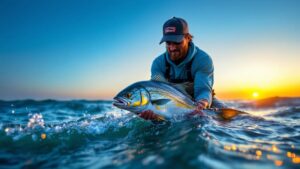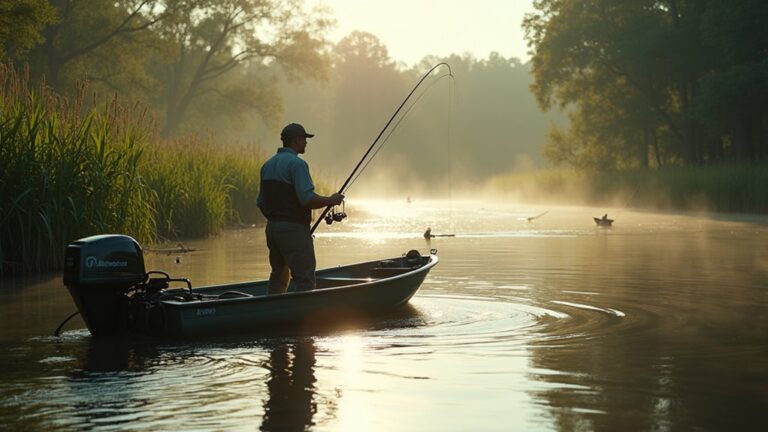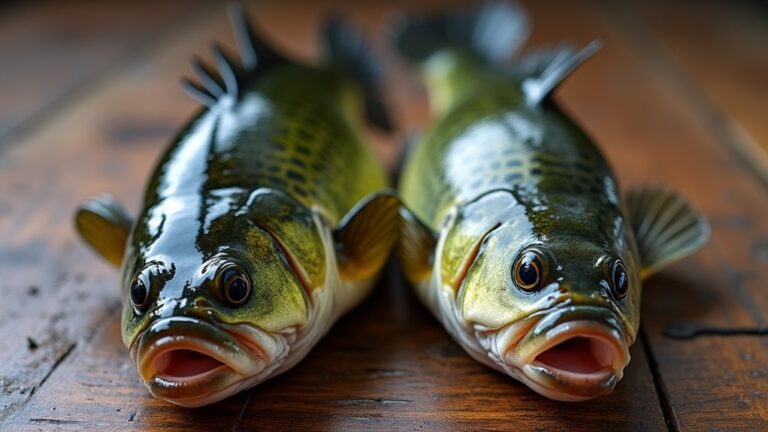To handle and release saltwater fish responsibly, keep these key steps in mind. Use wet hands or gloves when touching the fish to protect its slime layer. Limit their time out of water to reduce stress, and always support their body gently. When unhooking, use pliers to do it quickly and safely. A soft landing net can help minimize direct contact. Release the fish headfirst into the water, facing into the current to aid in a natural swim away. By following these practices, you'll promote the health of fish populations and the ecosystem. Discover more tips to enhance your fishing experience!
Understanding Fish Physiology
To truly appreciate saltwater fish, you need to understand their physiology. These creatures are uniquely adapted to thrive in saline environments, which is vital for their survival. Their gills extract oxygen from seawater, allowing them to breathe efficiently.
You'll notice that their bodies are streamlined, enabling swift movement through the water, which helps them evade predators and catch prey.
Saltwater fish also possess specialized cells called chloride cells that help regulate salt concentration in their bodies. This adaptation prevents dehydration and maintains osmotic balance.
You should remember that when fish experience stress, whether from handling or environmental changes, it can disrupt this balance and lead to serious health issues.
Additionally, their sensory systems are highly developed, with lateral lines detecting vibrations and changes in water pressure. This ability is fundamental for navigation and hunting.
Understanding these physiological traits not only enhances your appreciation for these fish but also emphasizes the importance of handling them with care. By recognizing how delicate their systems are, you can take steps to minimize stress and promote their well-being, ensuring a responsible fishing experience.
Choosing the Right Gear
Choosing the right gear is crucial for a successful and responsible saltwater fishing experience. Start with a suitable rod and reel that can handle the species you're targeting. A medium to heavy action rod paired with a spinning or baitcasting reel is often ideal for larger saltwater fish.
Next, select the appropriate line. Monofilament, braided, or fluorocarbon lines come in various strengths. For most saltwater fishing, a braided line offers high sensitivity and strength, making it easier to detect bites.
Don't overlook hooks and terminal tackle. Choose hooks that match the size of the bait and fish species. Circle hooks are often recommended because they reduce gut hooking, promoting better fish survival rates after release.
When it comes to lures, opt for those that mimic the natural prey in the area. Whether you're using jigs, spoons, or soft plastics, make sure they're durable and suited for saltwater conditions.
Proper Landing Techniques
Proper landing techniques are essential for ensuring the well-being of the fish and enhancing your fishing experience. When you've got a catch on the line, keep your rod tip up to maintain tension and prevent the fish from shaking loose. As you reel in, be patient—let the fish tire itself out before attempting to land it.
Once you're ready, position your net or landing device nearby. If you're using a net, make sure it's large enough to accommodate the fish without causing harm. Approach the fish calmly to avoid startling it, and gently guide it into the net.
If you're not using a net, try to bring the fish close to the boat or shore and grab it by the lower jaw or the tail, ensuring your hands are wet to reduce slime damage. Avoid lifting the fish by its gills, as this can cause serious injury.
Once you've successfully landed the fish, keep it low to the water to minimize stress. A smooth, controlled landing not only protects the fish but also makes your fishing experience more enjoyable.
Minimizing Air Exposure
Minimizing air exposure is crucial for the health of saltwater fish you catch. When a fish is out of water, its gills can dry out quickly, leading to stress or even death. To protect your catch, try to keep the fish in the water as much as possible. If you need to handle it, limit the time it's out of water to just a few seconds.
When you're ready to take a picture, keep the fish close to the water's surface. This way, you can quickly return it if needed. If you're using a net, wet it before you land the fish. This will reduce friction and help prevent damage to the fish's protective slime layer.
If you're measuring or weighing the fish, do it efficiently. Have your tools ready and minimize the time the fish spends in the air. If you can, use a fish-friendly cradle or mat to support the fish while you work.
Using Wet Hands or Gloves
Using wet hands or gloves when handling saltwater fish is vital for their well-being. When you immerse your hands in water or use a wet glove, you minimize the risk of damaging their delicate skin and scales.
The mucus layer that protects fish from infections is easily removed by dry hands, so keeping them wet is important.
Here are some tips to remember when handling saltwater fish:
- Gentle grip: Use a light touch to avoid squeezing or causing stress.
- Wet your hands: Soak them in the water before touching the fish to make sure they're not dry.
- Opt for gloves: If you prefer gloves, choose ones made of rubber or latex, as they can provide a barrier while keeping your grip secure.
- Avoid sharp objects: Steer clear of hooks or other sharp items that can accidentally harm the fish during handling.
Handling Fish With Care
Handling fish with care is crucial for their health and your success as an angler. When you catch a fish, the first step is to minimize stress. Keep the fish in the water as much as possible until you're ready to remove the hook.
If you need to lift it, support its body with both hands, avoiding any unnecessary pressure on its organs.
When you're ready to unhook, use pliers or a hook remover to quickly and safely take out the hook. If the fish is flopping around, try to stabilize it by holding it horizontally, which helps prevent injury.
Avoid holding fish by their gills or eyes, as this can cause serious harm.
If you plan to release the fish, do it gently. Place it back in the water headfirst to give it a chance to recover. You can also move it back and forth in the water to help oxygenate its gills.
Assessing Fish Health
Evaluating fish health is essential for ensuring the well-being of the species you catch and release. Before you put the fish back in the water, take a moment to assess its condition.
Look for signs that indicate whether the fish is fit to survive after release.
Here are some key indicators to check:
- Coloration: A healthy fish will have vibrant colors. Dull or faded colors can signal stress or illness.
- Gills and Eyes: Clear, bright eyes and healthy gills are signs that the fish is in good condition. Cloudy or damaged gills indicate potential problems.
- Body Condition: A well-fed fish will have a robust, smooth body. Look for any signs of emaciation or lesions on the skin.
- Behavior: Observe how the fish swims. A strong, purposeful swim suggests it's healthy, while erratic or sluggish movements may indicate distress.
Techniques for Safe Release
Once you've assessed the fish's health and confirmed it's fit for release, employing proper techniques is key to giving it the best chance of survival. Start by minimizing the time the fish spends out of water. If you need to handle it, wet your hands first to protect its slime coat. Use a landing net to avoid direct contact, and if you must use a grip, opt for the lower jaw instead of the gills.
When it's time to release, support the fish in an upright position. If it shows signs of stress, gently move it back and forth in the water to help it revive. Always face the fish into the current when releasing, allowing it to swim away naturally.
Here's a quick reference table for techniques:
| Technique | Description | Purpose |
|---|---|---|
| Minimize Air Time | Keep fish out of water briefly | Reduces stress |
| Wet Your Hands | Protects the slime coat | Maintains fish health |
| Support Upright | Hold the fish upright in water | Aids in recovery |
| Face Into Current | Release fish facing the current | Guarantees natural escape |
Reporting Your Catch
Many anglers overlook the importance of reporting their catch, but it plays a crucial role in fisheries management and conservation efforts. By sharing your data, you contribute to understanding fish populations and ensuring sustainable fishing practices.
Here's what you can do:
- Record the species: Knowing which fish are being caught helps track population health.
- Note the size and weight: This data assists in evaluating growth rates and stock productivity.
- Specify the location: Geographic data helps identify critical habitats and migration patterns.
- Report your method: Indicating how you caught the fish provides insights into fishing techniques that may impact populations.
You can report your catch through various platforms like local fish and wildlife agencies or online apps designed for anglers.
Even if you're releasing the fish, your information is crucial. It helps scientists make informed decisions about regulations and conservation strategies.
Conclusion
By handling and releasing saltwater fish responsibly, you not only contribute to the health of marine ecosystems but also guarantee future generations can enjoy fishing. Some might argue that catch-and-release isn't worth the effort, but every fish returned can spawn and maintain population levels, making your care essential. Embrace these practices, and you'll help preserve the thrill of fishing while protecting the delicate balance of our oceans. Together, we can make a difference, one fish at a time.




